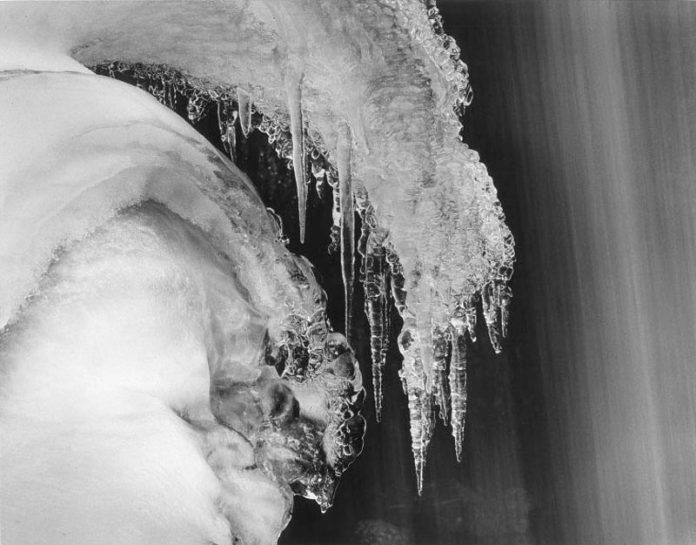Overwhelmed with snow and ice? Perhaps a look at Peter Dreyer’s photos, now on display at the Vineyard Haven library, will bring a newfound appreciation of the natural beauty of winter.
Mr. Dreyer’s series, “Freeze Frames,” gives the viewer an up-close look at the intricate patterns created by ice and frost. Crystalline formations, captive bubbles, lacy silhouettes, and sculpturally striking icicles are just some of the subjects in the photographer’s fascinating series of black-and-white shots.
The photos are beautiful when viewed as abstractions alone, and even more so as a series of the designs wrought by nature. The photos were taken over the course of a few years, here on Martha’s Vineyard and at a reservation in the Boston area, Mr. Dreyer’s former home.

In the artist statement accompanying the exhibit, the photographer explains his fascination with the effects of freezing temps on nature: “Severity of temperature, freezing, thawing, and refreezing, the movement of water before freezing — all contribute to images of an abstract quality. Black-and-white photography is of course a step toward abstraction in that it strips the world of its color. But then, ice is not colorful to begin with. Its beauty lies in the bubbles, cracks, and strange and wondrous forms and patterns locked into the ice surface, with leaves and other natural objects sometimes providing scale.”
Mr. Dreyer clearly has a passion for the photographic process and its potential for creating unique images. He shoots only with film, as opposed to digital, and develops his own work in his home darkroom.
“I love black-and-white,” Mr. Dreyer told The Times. “I’ve always tended toward abstract motifs.”
The idea for the “Freeze Frame” series came about while Mr. Dreyer was living in Westwood. “One winter I stepped out on our deck. I shot some interesting ice patterns,” he said. “I thought, ‘I should do more of this.’ I went into the woods, and I started wandering around there with my 4-by-5 camera. You have to lug around a heavy camera and a tripod to shoot large-format. I was finding interesting patterns, snow that had melted and refrozen. It was fascinating stuff. That was my first outing in art photography.”
The resulting series was exhibited at two galleries in Boston. Since then, Mr. Dreyer has added to the “Freeze Frame” selection of photos. Some of the images have been altered through various techniques. For example, one image of an icy rock in a brook was created using multiple short exposures. “While flowing water in these ice pictures usually looks almost black, in this instance the water surface looks completely different,” he said. “It has more detail.”
Another series that Mr. Dreyer has enjoyed working on is called “Reverse-Reflex”: double-exposure images in which the same scene is viewed simultaneously right-side-up and inverted for an unusual reflection effect. The photographer produced these with a double exposure — turning the camera 180 degrees to create identical images seemingly emerging from each other.
Although this effect could have been created by manipulating the original image, Mr. Dreyer prefers to use his own painstaking processes to create interesting viewpoints. “I do complicated stuff,” he said. “People say, ‘Peter, with Photoshop you can do in 10 minutes what it takes you all day to do.’ I have pride in the darkroom.”

Another series, titled “Photogram/Photographs,” was created with a technique popularized by the surrealist artist Man Ray. Photograms are produced with photographic materials, such as light-sensitive paper, but without a camera. Mr. Dreyer has taken the process one step farther by printing silhouette ghost images of objects superimposed over background photos.
This adherence to old methods comes in part from the photographer’s background. Born in Germany, Mr. Dreyer moved to Boston in 1962 to take a job as translator with the Christian Science Monitor. During his time with that publication, he developed an interest in filmmaking, and worked on documentaries for the paper. Eventually, he founded his own business working as a corporate and industrial photographer.
With the rise of digital photography, Mr. Dreyer retired in 2012 and moved to the Vineyard with his wife.
On-Island, Mr. Dreyer has shown his work at the Granary Gallery and the Louisa Gould Gallery. The current exhibit at the library marks the first Island showing of the “Freeze Frame” series.
Peter Dreyer’s photographs will be on display at the Vineyard Haven library as part of its Art in the Stacks series throughout the month of January. For more information, visit dreyerphoto.com or vhlibrary.org.
This article by Gwyn McAllister originally appeared on mvtimes.com.




